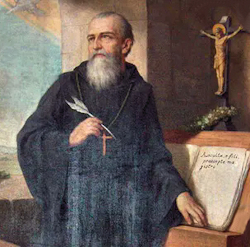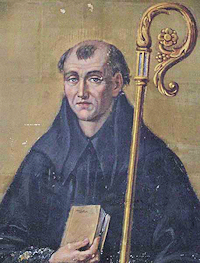Easter: April 17th
Saturday of the Second Week of Easter
Other Commemorations: St. Robert of Molesme, Abbot (RM)
» Enjoy our Liturgical Seasons series of e-books!
According to the 1962 Missal of St. John XXIII the Extraordinary Form of the Roman Rite, today is the feast of St. Ancetus, who was the tenth successor of St. Peter. He governed the Church from 155 to 166, years of great difficulty when Christianity in Rome had to face not only persecution by the emperors but also the heretical tendencies of the second century. St. Anicetus was visited in Rome by St. Polycarp, Bishop of Smyrna, who came to discuss with him the date of Easter.
According to the 1962 Missal of St. John XXIII the Extraordinary Form of the Roman Rite in England, today is the feast of St. Stephen Harding, at Citeaux in France who was first to live in the Cistercian desert and who joyfully welcomed St. Bernard and his companions when they came to him.
St. Robert of Molesme
 St. Robert was born in 1027 near Troyes, Champagne, France, of noble birth. At age 17 he entered the Benedictine Abbey Montier-la-Celle, quickly rising to be prior of the abbey. He was made Abbot of Saint-Michel-de-Tonnerre in 1070, but considered it to have lax standards and the monks were quarrelsome, so he returned to Montiers-la-Celle. The same year he was placed over the priory Prior of Saint-Ayeul Abbey, which was connected to Montiers-la-Celle.
St. Robert was born in 1027 near Troyes, Champagne, France, of noble birth. At age 17 he entered the Benedictine Abbey Montier-la-Celle, quickly rising to be prior of the abbey. He was made Abbot of Saint-Michel-de-Tonnerre in 1070, but considered it to have lax standards and the monks were quarrelsome, so he returned to Montiers-la-Celle. The same year he was placed over the priory Prior of Saint-Ayeul Abbey, which was connected to Montiers-la-Celle.
In 1075, in an attempt to return to a simpler form of Benedictine life requested by a group of hermits from the forests around Colan, France, he helped found the monastery at Molesme, Burgundy. The group, especially Robert, gained a reputation for piety. It is because of this reputation that in 1082 St. Bruno of Cologne came to Robert seeking advice. He lived with Robert's community for a time before going on to found the Grande Chartreuse, the first Carthusian monastery. , The growing reputation led to bequests of money, which led to an increase in size of the monastery, which led to internal difficulties, and suddenly there were many brothers that objected to the severe life practiced by the founders. Robert twice left to live on his own, but was ordered back to his position by the pope.
In early 1098 Robert, Saint Stephen Harding, Saint Alberic of Citeaux and 18 other monks left Molesme, and on March 21, they founded the monastery of Cîteaux near Dijon, France, with the goal of living strictly by the Benedictine Rule, strict vows of poverty, and frequent retreats; Robert served as the first abbot. However, with conditions deteriorating at the Molesme house he was re-assigned as abbot there in 1100 with a mandate to reform. The monks agreed to submit entirely to his interpretation of the Rule of St. Benedict. Molesme became a major center for the Benedictines under his tutelage. St. Albéric was made successor abbot at Cîteaux, with St. Stephen Harding as prior. St. Robert lived and worked in Molesme the rest of his life.
St. Robert is traditionally considered one of the founders of the Cistercians, the reform that developed at Citeaux.
—Adapted from Catholic Saints Info and Catholic Encyclopedia
Highlights and Things to Do:
- Read more about St Robert of Molesme:
- St. Robert's first founded Molesme Abbey, which now is only an historical monument, with a few surviving buildings. See more about the Shrine of Our Lady of Molene on that site.
- With St. Stephen Harding, St. Robert founded Citeaux Abbey. It was an activity monastery for the Cistercians (Trappists) until the French Revolution. In 1898 it was bought back by the Trappists and revitalized. More details can be read on Wikipedia.
- Read this brief guide on the Cistercian Order.
- See some art depictions of St. Robert.






